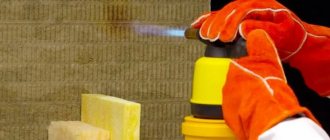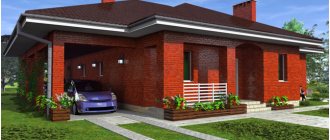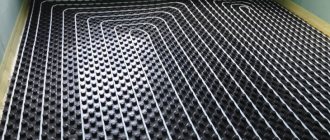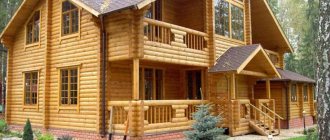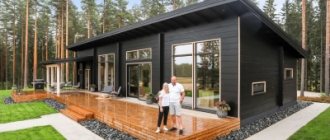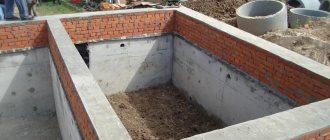The problem of insulating a house can be solved both at the construction stage and directly during operation. Moreover, this may be caused by the desire to make the home warmer and more comfortable, or dictated by objective reasons - to correct mistakes made during the design.
There are several options on how you can make your home warmer. It all depends on the degree of readiness of the building, the material and technology chosen for construction, as well as the financial capabilities of the homeowner.
How to build a warm house
Construction of comfortable housing begins with design. To reduce waste and time for finishing, the geometry of the building should be simple. A successful project in the future will allow you to maintain the temperature, remove excess moisture, and provide each room with sunlight.
Construction technology includes the following nuances:
- Construction of foundations and walls. According to the technology, the foundation should contain a small depression and be filled with a sand and gravel cushion with drainage. If you are designing a basement, it is necessary to waterproof the inside. When building the frame, take care of thermal insulation on the outside. The thickness of the walls depends on the material for insulation (mineral wool - 16 cm, wood - 45-54 cm, gas or foam concrete - 45 cm, brick - 208 cm).
- Insulation of the roof, floor, and other vulnerable places. Roofs are insulated with mineral wool, polystyrene, sprayed insulation material. Foamed concrete, expanded clay, and peat mats are often used for flooring. To prevent heat from escaping from windows and doors, additional structures are installed and a heat insulator is installed.
- Radiator location, pipe routing. This work is carried out by a specialist who knows the technology of pipe installation and correctly calculates heat loss. The installed heating should heat all rooms evenly.
- Supply and exhaust ventilation device. Every day, up to 15 liters of water are produced in a living room (breathing, cooking, cleaning, going to the bathroom). To avoid creating the feeling of a greenhouse, an exhaust system is needed.
Constructed houses are insulated along the perimeter only from the street side. At the same time, normal heat and moisture exchange between the wall and the insulation is maintained. Internal insulation promotes condensation.
Currently, new technologies are being developed to produce buildings constructed in the most economical way with minimal wall thickness. In this case, the principle of multi-layering is used: the frame is erected with insulation, and then the facade is laid out.
Material selection
The ability of a building to retain heat indoors depends on the material from which the building is constructed. Therefore, during construction, it is necessary to decide what to build the housing from, what will become the frame and finishing material for the facade.
- Brick is a good basis for building walls; you can build the warmest private house from it. However, pure masonry buildings will be too expensive. The thickness of the walls for the Russian climate should be 0.8-1.5 m, for the southern regions - 0.3-0.5 m. Additionally, the technology will require insulation with polystyrene, mineral wool, and polystyrene foam.
- Aerated concrete is used to build a house that will be warm in winter and cool in summer. A concrete building does not require additional insulation, and for construction it is enough to build a wall in one layer (0.5 m).
- Wood allows you to build the warmest house that can withstand winter climates; it can be easily warmed up in a few hours even in severe frost. Additionally, it is insulated from the outside or inside with a membrane that protects against steam, and all cracks are also sealed.
- timber - wooden housing can have walls 1.5-2.4 m thick;
- logs - 2.4-2.8 m is enough for permanent residence.
- Ceramic walls are durable and maintain a comfortable temperature. The porous stone has properties similar to brick and serves as insulation.
You may be interested in: Nuances of planning a house in a high-tech style
To build a house, you can use frame technology. The frame of the building is made of timber and multilayer sandwiches with sealed filler. The outer layer is lined with boards, clapboard, gypsum, OSB.
Electric boilers
It must be said that electric heating is the most efficient of all existing ones. Not only are the efficiency of boilers about 99%, but in addition they do not require chimneys or ventilation. There is practically no maintenance of the units as such, except for cleaning once every 2-3 years. And most importantly: equipment and installation are very cheap, and the degree of automation can be any. The boiler simply does not need your attention.
No matter how pleasant the advantages of an electric boiler are, the main disadvantage is just as significant - the price of electricity. Even if you use a multi-tariff electricity meter, you will not be able to beat a wood-burning heat generator in terms of this indicator. This is the price to pay for comfort, reliability and high efficiency. Well, the second disadvantage is the lack of the necessary electrical power on the supply networks. Such an annoying nuisance can immediately cancel out all thoughts about electric heating.
The best construction technologies
The best construction technology is the construction of a frame base, which does not require additional waste and insulation measures. The basis is a reliable block of polystyrene permanent formwork connected by jumpers. To prevent the room from blowing in and to retain heat in winter, a layer of sound insulation is added to the floor.
The construction of brick housing is carried out using the laying of supporting and finishing bricks and insulation. Such a building has an increased heat capacity. It can be heated in a few hours, and the room temperature remains the same throughout the night. The technology does not use mineral wool, which does not allow moisture to pass through well, is susceptible to destruction, and creates a greenhouse effect.
In order to comply with the standards for supplying heat to a residential building when designing, it is necessary to study Federal Law No. 261-FZ. A cold, drafty building wastes a lot of fuel. Therefore, heating becomes expensive for owners and also depletes national resources.
Solid fuel boilers
Solid fuel boilers are divided into 3 types: direct combustion, pyrolysis and pellet. The units are popular due to their low operating costs, because compared to other energy sources, firewood and coal are inexpensive. The exception is natural gas in the Russian Federation, but connecting to it is often more expensive than all the heating equipment including installation. Therefore, wood and coal boilers, which have an acceptable cost, are being purchased by people more and more often.
On the other hand, operating a solid fuel heat source is very similar to simple stove heating. You need to spend time and effort to prepare, carry firewood and load it into the firebox. The unit also requires serious piping to ensure its long-lasting and safe operation. After all, a conventional solid fuel boiler is characterized by inertia, that is, after closing the air damper, the heating of water does not stop immediately. And efficient use of generated energy is possible only if there is a heat accumulator.
Important. Boilers that burn solid fuels generally cannot boast of high efficiency. Traditional direct combustion units have an efficiency of about 75%, pyrolysis units - 80%, and pellet units - no more than 83%.
The best choice in terms of comfort is a pellet heat generator, characterized by a high level of automation and virtually no inertia. It does not require a heat accumulator and frequent trips to the boiler room. But the price of equipment and pellets often makes it inaccessible to a wide range of users.
Features of modern insulation
You can make your home warmer yourself using roll or panel insulation. They are mounted on a vertical or horizontal grille, on a plate-shaped dowel-umbrella. Some types of materials are applied using sprayers or expensive construction equipment.
You can choose the type of insulation by studying its characteristics. In modern construction, exterior wall decoration is carried out with the following materials:
- Mineral insulation is an environmentally friendly and non-flammable material that is suitable for finishing any surface;
- Polystyrene or polystyrene foam is an economical material, suitable for insulating brick and aerated concrete surfaces, has a high degree of flammability;
- Eco-wool is a fire-resistant and environmentally friendly material, applied by spraying;
- Polyurethane foam - suitable for additional insulation of a wooden building, processing its frame and cracks, resistant to steam penetration;
- Ceramic insulation - applied by painting or spraying, creates 1-5 mm of unbreakable film.
Ceramic insulation is suitable for owners of designer buildings with uneven walls, broken lines, and spherical elements.
What are the types of heat loss?
Let’s conditionally divide them into 2 types:
1. Natural – these are significant heat losses through the windows, roof and walls of the house. Even if your house is built perfectly, its roof and walls are sufficiently insulated, it will still lose some heat. It will not be possible to avoid such losses, but minimizing them is quite possible. How? Read on!
2. “Heat leaks” are heat losses that can be detected and completely eliminated. These heat losses can be identified independently, but only in those cases when the cracks actually begin to “siphon.” Of course, in modern country houses and cottages this happens extremely rarely. Most often, it is impossible to visually detect such leaks.
Any heated house can be compared to a chimney, when warm air comes out of it, and cold air tends to penetrate into the room. Due to the difference in pressure inside and outside the house, the same thing happens. Moreover, the “chimney” phenomenon occurs not only when windows or doors are open, but also when there are small cracks and cracks in the building that are invisible to the eye.
To clearly understand how heat leaves the house, let's first understand how heat transfer in space can occur. After all, in order for your home to become truly warm, you need to reliably block all escape routes for warm air.
So, let's look further at how exactly heat is lost.
Vulnerabilities
When building housing using technology, it is necessary to study vulnerable areas; up to 40% of heat passes through them. Without taking these features into account, even a small house in winter will require a large amount of resources and will spend the budget on heating the room.
The main directions through which heat leaves the room:
- Floor on the ground or foundation of a wooden house;
- Ceiling, roof, attic with insufficient insulation;
- The walls were not insulated during construction;
- Windows, doors with improper installation, insufficient insulation;
- Ventilation system, chimneys if installed incorrectly.
You may be interested in: Choosing the right facade material and color for your home
When creating a project, a heating system is considered that can deliver heat and hot water to the room. In private housing, autonomous heating is provided. Heating is provided by a gas, solid fuel, electric or liquid fuel boiler.
Recommendations for choosing a boiler
At the moment, there are various types of heating, characterized by the energy carrier or type of fuel used. Which one to choose is up to you, and we will present all types of boilers with a brief description of their pros and cons. To heat residential buildings, you can purchase the following types of household heat generators:
- solid fuel;
- gas;
- electrical;
- on liquid fuel.
The following video will help you choose an energy carrier, and then a heat source:
Proper insulation of a finished house
Many people are interested in how to make existing housing more comfortable and economical in winter and autumn. This is done by installing external insulation, installing insulation on the floor and attic.
Each joint and crevice of a wooden building must be treated with sealant, and waterproofing is laid on the floor using a certain technology. Expanded clay, cork slabs, mineral wool, and polystyrene foam are suitable for insulating a stone building. For a stone floor, it is necessary to raise it on concrete joists or dismantle the finished screed.
Liquid fuel boilers
In terms of the cost of heating equipment and its installation, heating with waste oil or diesel fuel will cost approximately the same as with natural gas. Their efficiency indicators are also similar, although the processing, for obvious reasons, is somewhat inferior. Another thing is that this type of heating can easily be called the dirtiest. Any visit to the boiler room will end with at least the smell of diesel fuel or dirty hands. And the annual cleaning of the unit is a whole event, after which you will be smeared with soot up to your waist.
Using diesel fuel for heating is not the most profitable solution; the price of fuel can hit your pocket hard. Used oil has also risen in price, unless you have some cheap source. This means that it makes sense to install a diesel boiler when there are no other energy sources or, in the future, a main gas supply. The unit easily switches from diesel fuel to gas, but the exhaust furnace will not be able to burn methane.
Penoizol
Liquid carbamide foam plastic (penoizol) is convenient because it can be poured directly at a construction site. It perfectly fills all irregularities and voids without expanding in volume. However, it is possible to obtain a high-quality coating without cracks only at temperatures up to +5°C.
Working in the cold with it is strictly prohibited.
Carbamide foam is also produced in the form of slabs or crumbs, called thermal wool, blown into hollow frames. The absence of seams is the most important advantage of the material. It is used to insulate walls, attics, roof spaces or as a layer in brick walls.
Thermal insulation with foam insulation
In terms of service life, it exceeds conventional foam plastic or extruded polystyrene foam - the service life can be up to 80 years. Builders often complain about its low strength, but this is due to the use of penoizol of insufficient density. The improved material is not inferior in strength to flexible and dense polystyrene foam.
The porous structure of carbamide foam allows for good vapor removal. However, due to its ability to absorb liquid, it requires moisture protection. Not only film followed by finishing with durable panels, but also cement-sand plaster can serve as waterproofing.
Thermal insulation plaster
This type of heat insulator is another novelty in the construction market. The main binder in it is lime or Portland cement. Various stabilizers and plasticizers are also added to them. But the main component (up to 40-75%) in heat-insulating plaster is porous insulation in the form of foamed perlite, vermiculite or foam balls.
A layer of such a mixture of only 50 mm is equal in its thermal insulation properties to a masonry of 2 bricks. Plus, you can use it, just like a regular one, to level walls and use it as a decorative finish. Moreover, it weighs 3-4 times less than ordinary plaster. Warm plaster can be used for ceilings, walls, window and door slopes, pipelines, as well as interior finishing work.
A layer of thermal insulation plaster
The technology for applying heat-insulating plaster is almost identical to the usual method - the mixture is distributed using a conventional spatula or mechanical sprayers. It adheres well to the surface, so a small layer can be applied even without a reinforcing mesh.
This material is able to “breathe”, allowing steam to pass through, and has sufficient water-repellent properties. Due to the absence of seams, warm plaster does not form cold bridges. In addition, it is non-flammable and can protect buildings from accidental fire.
Foundation, floors
Insulation of the foundation of the house itself serves as the basis for thermal protection of your home. Foundation insulation with expanded clay is significantly outdated; today the most effective and economical method is insulation with polymer materials. Let's consider the option of polystyrene foam insulation.
Calculate materials. Take a careful measurement of the foundation, consider possible options for covering it and choose the optimal one. This will help reduce costs on materials.
Next, cover the foundation layers with material. It is difficult to give general advice, since foundation designs may differ. The insulating material should fit tightly to the structure and not leave air pockets.
Use pre-cutting when laying out polystyrene foam boards. Make sure that the surface created by the slabs is level using a level.
In the photo, insulating a house with polystyrene foam boards with your own hands looks difficult, but in reality there should not be any difficulties, unlike, for example, laying out ceramic tiles.
Next, a layer of insulation, a concrete covering, and a finishing floor covering are laid.
This multi-layer insulation scheme will protect the building even from extreme cold.
News site- Features of electrical wiring installation in houses made of SIP panels
- How to choose a cast iron bath
Gas heating
Gas heating of a dacha is a complex engineering system. Before installing expensive equipment, you need to ensure good thermal insulation. An ideal system should operate silently, economically, warmly, and unnoticeably. Gas equipment requires constant maintenance and preparation for the winter season. Maintenance must be carried out by certified specialists.
A water system is best suited for gas heating. If the system will not be filled in winter, the pipes must be filled with antifreeze. This nuance will protect the system from defrosting. Installation of gas equipment includes the installation of radiators that will give off their heat to the room. Installation of a heating system has its own characteristics, which a specialist must warn about.
Warm roof installation
As you know, warm air masses in a room always rise. Therefore, insulation of not only the foundation, walls, but also roofs is required. Especially if the attic space is residential or used for other purposes. In winter it will be better to retain the necessary heat, and in summer it will be cooler.
The whole process is not very complicated if you know how to make a warm roof for a house correctly. The structure itself will consist of many layers. Waterproofing and windproofing are installed during the installation of the roof. It is necessary to protect the insulation from condensation. Since temperature changes and exposure to sunlight cannot be avoided. For this purpose, special polypropylene films are used, vapor-permeable, with special coatings.
Next comes thermal insulation. Typically, glass wool or polystyrene foam boards with the best characteristics are selected. The next layer is a vapor barrier necessary to protect the insulation. Since moisture, getting on such a material, neutralizes its beneficial properties. All this should be taken into account before making a warm roof for a house, and take care of the quality of the materials used.
Insulating a house with mineral wool - see here
Heat leaks with air convection
Warm air rushes upward, where it meets an object and transfers its heat to it; after cooling, it falls down, i.e. convection movement of air with heat transfer occurs. This is how air circulates in the house from the heating radiator to the ceiling and in the reverse order.
But such convection can be either natural, as described above, or pathological.
A striking example of pathological convection is the movement of air in a layer of insulation with large gaps between the fibers. For example, in a layer of loose mineral wool, etc.
The air moves from the edge of the insulation to its center, where it heats up and rushes upward, leaving the material and taking its heat. Thus, this layer loses its thermal insulation properties.
To prevent this phenomenon, you need to cover the insulation with a thick layer, for example, paper and sprinkle with sand. In this case, steam will still move.
Liquid polyurethane foam
Application of liquid polyurethane foam
This material is produced using two components: a polyol and a polyisocyanate. The release of carbon dioxide during their interaction makes it possible to obtain surfaces with a foam structure.
Polyurethane foam is available in two modifications:
- with closed voids: has better strength and heat-insulating characteristics, but removes moisture from the walls worse; it, like slab polyurethane, is best used for insulating foundations
- with open voids: widely used for finishing walls, roofs, attics, especially inclined structures
Liquid polyurethane foam is more expensive than penoizol, but has better technical characteristics. It is more durable and elastic, absorbs less moisture. According to manufacturers, this heat insulator, subject to application technology and proper operation, can last up to 50 years.
The disadvantages of liquid polyurethane foam include poor resistance to ultraviolet radiation - surfaces filled with it cannot be left open for a long time. It also does not adhere well to cold walls, so it is necessary to work with it only at positive temperatures. Just like sheet polyurethane foam, the material is flammable and therefore requires additional protection.
Basic Rules
You need to approach insulation wisely and not skimp on materials. After all, if the procedure is carried out poorly, the repair will cost many times more. It is recommended to do the insulation of a private house with your own hands from the outside.
Why? Firstly, using insulation inside rooms will reduce their area. Secondly, condensation that forms between the insulation layer and the wall can cause the boards to rot.
Another tip: layers of thermal insulation should be laid according to their vapor permeability - from least to most. If condensation accumulates on some layer, fungi develop.
Installation and replacement of pumps
One of the main activities of our company is the replacement and installation of water pumps of all types: surface, submersible and semi-submersible. The company’s specialists with extensive experience will install, dismantle and install the following pumping equipment in the shortest possible time:
- borehole pumps;
- well pumps;
- water pumps;
- circulation pumps;
- booster pumps;
- irrigation pumps.
In addition to installing and replacing pumps, we also carry out work on complex pumping stations, carrying out complex operations for installation, dismantling and installation of equipment.
Sources
- https://sdelat-dom.ru/remont/otoplenie/otoplenie-chastnogo-doma/
- https://cotlix.com/otoplenie-v-chastnom-dome-svoimi-rukami-podrobnoe-rukovodstvo
- https://sovet-ingenera.com/otoplenie/razvodka-o/razvodka-otopleniya-v-chastnom-dome.html
- https://master-houses.ru/shemy-otopleniya-dlya-chastnogo-doma-kakie-luchshe/
- https://oboiman.ru/teplo/sistemy-otoplenia-castnogo-doma-svoimi-rukami-shemy-razvodki.html
- https://otivent.com/kak-sdelat-otoplenie-chastnogo-doma-ili-kvartiry
- https://www.tproekt.com/razvodka-otoplenia-v-castnom-dome-svoimi-rukami/
[collapse]
